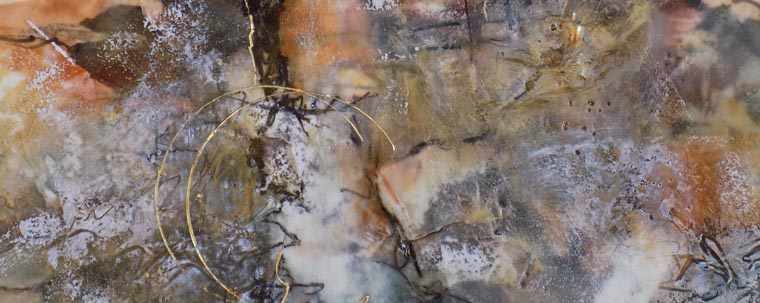 |
| From Silence into Words 7" x 21" x2 1/2" Beeswax. Mixed Media onto Artist Made Paper |
― Natsuki Takaya
The quote by Natsuki Takava sums up the next step in the path, Right Speech. Words are powerful for good and for harm. The path would advise us to spend a good amount of time with no words, in silence, so that we become aware of our inner words. I am personally on this step and although I have spent much of my early life in the silence of the convent, it is hard to quiet all of the inner noise of my own thoughts and feelings. Right Speech would have us silent when we are tempted to speak from anger, greed, or resentment. Right Speech would have us be aware of others and situations so that our words are appropriate. Too often in conversation we are consumed with our own options or positions and fail to listen and understand the perspective of the other or simply blurt out what is on our minds. Right Speech would have us speak the truth, without exaggeration or omission, with honesty and sincerity. Most importantly, Right Speech invites us to be aware of the power of our words to heal or hurt, to build up or tear down, to be crude and malicious or meaningful and uplifting. Until our inner words align with our outer words and all is an expression of kindness, we are instructed by Right Speech to remain silent.
 |
| Singing Praise for the Morning 7" x 21" x 2 1/2" Beeswax, Mixed Media onto Artist Made Paper |
Generosity of mind, spirit and words is the centerpiece of Right Action. And generosity is founded in the virtue of Gratitude. Gratitude is the ability to see abundance in all things..in creation..in the experiences of our life...in others. From Christian spirituality we know that a virtue is a practice that becomes so habitual that it is an attitude in which we live. I once met a wise older woman in one of my classes. She often spontaneously broke out in song or in words of admiration for a color that she experienced as beautiful or when looking at her finished art that she thought good. In all of the six weeks of the class, I never heard her say one word that wasn't filled with gratitude for the beauty around her. It was not wonder that everyone was drawn to her because her gratitude overflowed into an immense generosity of words of praise, actions of gift giving and a self-less listening. I've previously understood this step in the light of the Gospel, "Give. When you give, don't let your right hand know what your left hand is doing." Grounded in the virtue of Gratitude, I now understand that Right Action is something that simply cannot be contained. Generosity becomes the essence of who we are.
 |
| Living Uncompromising Life 7" x 21" x 2 1/2" Beeswax, Mixed Media on Artist Made Paper |
Right Livelihood is seen in terms of ethical livelihood, meaning that our work does not involve producing products or engaging in practices that cause harm to other living community of beings. It takes discernment, consultation with a spiritual adviser and much prayer to step into Right Livelihood.
 |
| All I Need is Here 7" x 21" x 2 1/2" Beeswax, Mixed Media on Artist Made Paper |
Right Effort is the step that will take us through the rest of our life. It is the step that is least about fan fare and most about being where we are. David Smith, in his book A Record of Awakening, describes this step in this way: "I would say from my experience and observation that the great challenge we in the West face...is to develop the ability to stay with the practice. It is not difficult to observe people wandering around changing teachers and traditions, avoiding practice when they are not getting what they thing they should be getting from their efforts, or just avoiding themselves with their restless wanderings. The willingness to stick with things is the most difficult aspect of practice that we face because it is going against the current that has been carrying us along all our lives."
In this culture of instant gratification, it is difficult to endure...to be in the moment...to stay with the practice...to deny both the illusion of grandeur and the illusion that there are short cuts to insight. Probably one of the most difficult part of this step is to realize that we don't need to go to a magic place or study with the perfect teacher or read that ground breaking book. The terrain of our journey is right where we are. Our teachers are those whom we meet around the dinner table and in the pews next to us. The ground breaking book is being written in the silence of our own inner words.
I've titled the last piece in this series, All I Need is Here, because it sums up the Eightfold Path. The spiritual path begins where we are, as we are, with whom we are with. It is a life long process of becoming authentically human...and perhaps, if we are faithful...the reign of God.
When you make the Inner as the Outer
and the Outer as the Inner
and the Above as the Below
And when you make the male and the female
into a single one where the male shall not be male
and the female shall not be female,
Than you shall enter the reign of God.
Gnostic Gospel of Thomas




.jpg)



.jpg)
.jpg)



